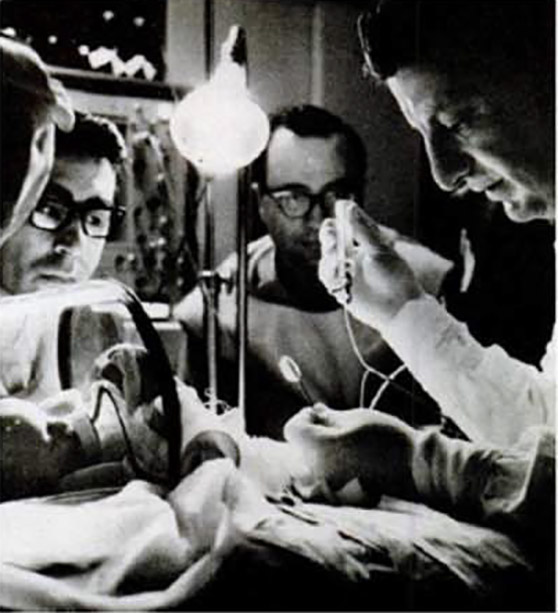William Rashkind: The Father of Interventional Cardiology

Dr. Rashkind holding a balloon catheter
Transposition of the great arteries (TGA) is a cyanotic congenital heart disease (CCHD) in which the two main arteries leaving the heart are reversed, with the aorta arising from the right ventricle and the pulmonary artery from the left ventricle, thereby causing oxygen-poor blood to be pumped throughout the body without passing through the lungs. Before the advent of open-heart surgery, children with TGA died within the first six months of life.
The middle of the twentieth century saw great advancements in cardiothoracic surgery in both the adult and pediatric populations. Drs. Alfred Blalock and C. Rollins Hanlon, along with their surgical collaborator Vivien Thomas, developed a surgical technique, known as an atrial septectomy, to partially restore systemic oxygenated blood in TGA patients. Requiring a thoracotomy, the Blalock-Hanlon operation was technically difficult and had a 20-50% mortality rate. In 1966, Dr. William Rashkind, a pediatric cardiologist at the Children’s Hospital of Philadelphia, described a technique used on a pediatric TGA patient(1). Briefly, a double-lumen cardiac catheter was advanced into the right atrium whereupon it was passed through the minimally patent foramen ovale into the left atrium, the balloon on the catheter was then inflated and withdrawn, creating an atrial septal defect that provided an increased availability of oxygenated blood. This procedure, known as the first balloon atrial septostomy, provided a non-surgical palliative strategy to address TGA. The success and importance of this procedure was quickly appreciated, and in June of 1966 Dr. Rashkind was featured in Life Magazine in recognition of this achievement. The balloon atrial septostomy, today widely known as the Rashkind Procedure, resulted in a paradigm shift in the care of children with TGA, with more infants surviving the first few months of life and growing to a size that increased their chance of survival for subsequent corrective surgery of their congenital heart disease. Because this landmark clinical research, Dr. William Rashkind is considered by many to be the “father of interventional cardiology”.
In addition to the balloon catheter described above, Dr. Rashkind developed a spring activated occluder system to close patent ductus arteriosis. Variations of this device have also been used to close ventricular septal defects in pediatric patients (2). Thus, in addition to his role in initiating the field of interventional cardiology, Dr. Rashkind was recognized as a leading innovator in the field Pediatric Cardiologist(3). Together, Dr. Rashkind’s advances upon cardiac catheterization and his commitment to advancing pediatric cardiology makes him a pioneer in the field of pediatric medical devices.
- Rashkind WJ, Miller WW. Creation of an atrial septal defect without thoracotomy. A palliative approach to complete transposition of the great arteries. JAMA. 1966;196(11):991-2.
- Moore JW, George L, Kirkpatrick SE, Mathewson JW, Spicer RL, Uzark K, et al. Percutaneous closure of the small patent ductus arteriosus using occluding spring coils. J Am Coll Cardiol. 1994;23(3):759-65.
- McNamara DG. Twenty-five years of progress in the medical treatment of pediatric and congenital heart disease. J Am Coll Cardiol. 1983;1(1):264-73.


